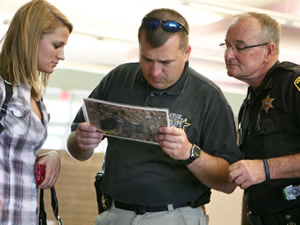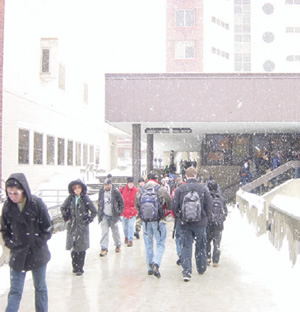Monitoring a Safe Campus Checklist
Planning, training and vigilance are three key aspects of routine safety procedures for everyone on campus.
- By Sherrie Negrea
- 12/01/13

PHOTO COURTESY OF CARL SANDBURG COLLEGE
Whether it's a hurricane, a fire or a blizzard, emergencies that arise on college campuses require an immediate reaction to protect students, faculty and staff. When emergencies do occur, one way to prevent them from turning into tragedies is to develop a safety checklist and train staff on how to implement it.
“You do not want to be practicing on game day,” says Glenn Rosenberg, vice president of higher education for AlliedBarton Security Services, which oversees security programs for 150 campuses. “When something happens, you want to know there’s a plan in place and that your plan is put into action.”
Since 2010, colleges and universities have been required to develop a campus emergency plan because of an update to the Jeanne Clery Act, the federal law that mandates higher educational institutions to disclose their security policies and provide timely warnings about immediate or ongoing threats, among other regulations involving crime reporting.
All-Hazards Planning
“That caused institutions to look on an all-hazards level what represents the greatest risk to their institution and then to build a policy around what those greatest risks are,” says Rick Amweg, executive director of the Center for P-20 Safety and Security for the Ohio Board of Regents and the Ohio Department of Education. “For some institutions, tornadoes are the greatest risk, while for others, flood is the greatest risk. They have to build plans that take those issues into account, as well as the more dramatic things such as bombs and shootings.”
No matter what is the most likely hazard at an institution, one of the major features of a safe campus is providing adequate lighting along highly trafficked walking routes and around residence halls, dining halls, libraries and athletic facilities. On many campuses, blue light phones, which automatically contact campus police when the receiver is lifted, are also an essential element for creating a secure campus. Lighting and
Communication Systems
Steven DiSalvo, president of Saint Anselm College in Manchester, NH, says adequate lighting and emergency phones are the “two most important things” that can make a campus safe. Another essential element is ensuring that campus security can notify faculty, staff and students when cell phone coverage is lost.
“What we’ve learned in the past is if your cell phones go out, you have no means of communication,” DiSalvo says. “You need to have a means to communicate with your public safety officers and your residence life and food service teams.”
If cell phone coverage were to fail, Saint Anselm College could send out a communication alert via a siren or audio system that can be heard throughout campus. The college’s bell tower also doubles as a speaker system that is audible across the 150-acre, built-up section of campus.
Maintaining Power
Another critical safety feature on college campuses is ensuring that there are enough generators to operate buildings in the case of a power outage. The need to rely on generators was put to the test at Post University, a private, for-profit university in Waterbury, CT, when Hurricane Sandy battered the Northeast coast in October 2012.
The storm knocked out power at the university for five days, but buildings on the lowest level of the campus nestled on a hillside remained with electricity. While the majority of the students went home after the hurricane landed, more than 100 remained on campus and were relocated to a building where they had lodging and hot meals served three times a day.
“When in doubt, have as many generators as you can,” says Scott Allen, vice president for finance and administration at Post.
While the generators helped keep the university operating, what didn’t work so well during the hurricane was providing timely communication to parents, some of whom mistakenly believed that students didn’t have access to food. Noting that accurate information was not conveyed to parents, Allen says that the university should have relied more on social media channels, such as Twitter, to provide regular updates.
Fire Drills
While not all colleges and universities would identify a hurricane as a potential hazard, all institutions must deal with the potential threat of fire. The number of fire drills and inspections of fire equipment varies by state; Ohio, which models its regulations on national codes, requires four fire drills a year and annual inspection of fire equipment, such as alarms, on college campuses.
Some colleges, such as Saint Anselm, inspect fire alarms twice a year. At the college, residence hall staff members check smoke detectors, while campus security officers monitor lighting and emergency phones.
“I can’t say there’s one big checklist to make campus safe,” DiSalvo says. “Some are things that we do on a regular basis.”
Other schools, such as Post, use private companies to monitor their fire equipment. Post has contracted with Siemens, a firm that provides security systems on college campuses, to maintain its fire protection. The company visits the university at least twice a year to test its alarms and smoke detectors, Allen says.

PHOTO COURTESY OF DANIEL NUGENT
THE WEATHER OUTSIDE IS FRIGHTFUL. Whether it’s snow in north, hurricanes in the southeast, tornadoes in the Midwest, flooding, wildfires, earthquakes or any other form of weather-related or natural disaster, an integral part of a college or university’s safety plan should include managing the hazards that arrive on campus with these adverse conditions. Updates on current conditions can be broadcast through text messages, social media or the main website, while general policies for dealing with potential conditions should be part of a formal, written safety plan.
Adverse Weather
For colleges and universities in the northern half of the country, snow is another hazard that can present a challenge to students navigating around a college campus. Camden County College in New Jersey annually posts articles on its electronic media offering tips on how to drive in the snow and walk on icy sidewalks. The college also works to insure that all walkways on its campus are cleared in the winter.
“We are very safety-conscious when it comes to sidewalk slips and falls,” says Edward Carney, the college’s executive director for safety and facilities.
A challenge that all higher educational institutions face, no matter where they’re located, is the issue of training faculty and staff on how to make their campuses safe. To reach more faculty members, especially those who teach part-time at night, Camden County College developed an electronic training program that covers everything from ergonomics to bullying. As a result, the percentage of staff that took the training at the two-year college increased from 50 to 90 percent in the past year, Carney says.
“In order to create a safe campus, you have to make your employees think about safety all the time, because the students aren’t the ones who are going to find the hazards,” Carney says. “They are the ones who are going to be victims of the hazards. You have to have your employees in constant vigilance and reporting the things that are not safe.”
Involving Everyone
In addition developing a campus emergency plan and training safety and security staff members on its implementation, it is vital that all members of the campus community — including other staff, faculty, students and even visitors — are informed of what to do in case of an emergency. To that end, many institutions and agencies offer safety checklists for both their on- and off-campus communities. Here are just a few examples of what is available.
- Through its off-campus student services, Boston’s Emerson College provides safety checklists for students deciding where to live, highlighting concerns for apartment safety, neighborhood safety and additional safety tips (emerson.edu).
- The Center for Campus Fire Safety provides a downloadable PDF for students titled “Safe on Campus Checklist,” available on the Center’s website (campusfiresafety.org).
- Along with a library of campus safety documents, The University of Hawaii Community Colleges system offers its personnel a detailed “Handbook for Campus Safety and Security Reporting,” downloadable in PDF format (uhcc.hawaii.edu).
- The strategic goal of Purdue University’s Integrated Safety Plan (ISP) is to promote safety and compliance throughout the campus community. A self-audit checklist is available on the university’s website along with detailed information on the ISP (purdue.edu).
This article originally appeared in the College Planning & Management December 2013 issue of Spaces4Learning.